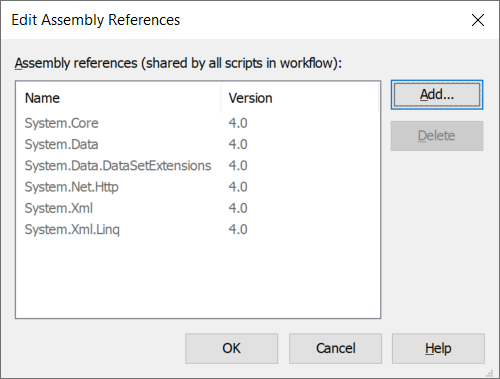Assembly References in .NET Scripts
You can use assembly references in your .NET scripts. Both standard and custom assemblies can be used.
By default, the following references to standard .NET assemblies are added into all scripts:
| Assembly | Description |
|---|---|
| System.Core | Core .NET classes (System.Linq and others) |
| System.Data | ADO.NET |
| System.Data.DataSetExtensions | DataTableExtensions |
| System.Net.Http | Support for HTTP: HttpClient and others. |
| System.Xml | XML support |
| System.Xml.Linq | Support for LINQ to XML |
Adding an assembly reference
To add an assembly reference into your script:
- Click the
 button in the Script Editor dialog box. You will be prompted to save your current script. After you save or discard your current script, the Edit Assembly References dialog box will open.
button in the Script Editor dialog box. You will be prompted to save your current script. After you save or discard your current script, the Edit Assembly References dialog box will open.
- Click the Add... button to open the Add Assembly dialog box.

The Type attribute may have one of the following two values:
| Value | Description |
|---|---|
| StandardAssemblyName | A reference to a GAC assembly. You can use the full name or a partial name of an assembly for the value of the Name attribute. You can also specify an assembly name without an extension. |
| FileName | The path to an assembly file. You can use the full path or a relative path for the value of the Name attribute. Relative paths are resolved relative to the Bin subfolder of the folder where ABBYY FineReader Server is installed. |
26.03.2024 13:49:49